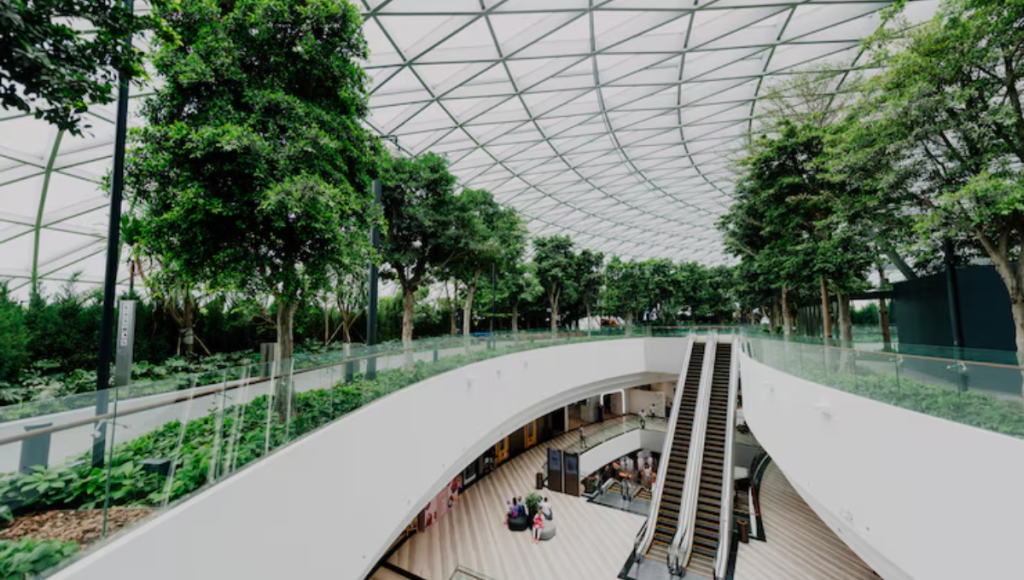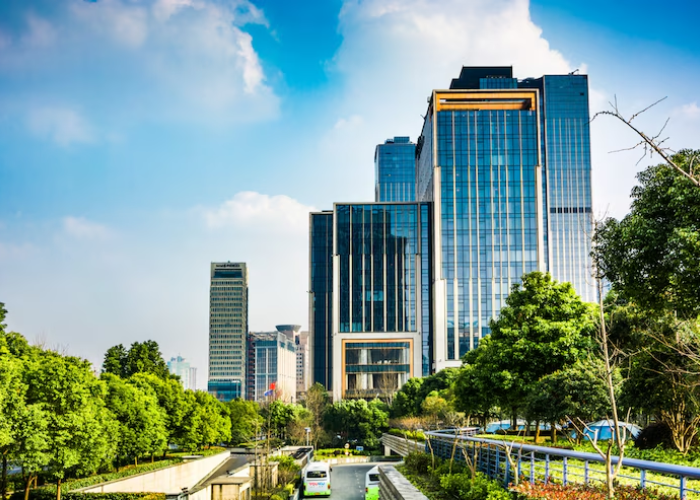A business park represents one of the most significant developments in commercial real estate, offering companies a strategic location that combines accessibility, functionality, and growth potential. As the American economy continues to evolve in 2025, understanding what a business park can offer your organization has become more crucial than ever.
Must Read: Iowa Business Entity Search | Verify Iowa Companies Easily
What is a Business Park?
A businesspark is a planned commercial development designed specifically to accommodate multiple businesses within a single, well-organized complex. These developments typically feature a mix of office buildings, light industrial facilities, research centers, and supporting amenities, all strategically positioned to create a thriving business ecosystem.
Unlike traditional commercial districts that evolved organically over time, a business park follows deliberate design principles that prioritize functionality, aesthetics, and business synergy. These developments often span hundreds of acres and can house dozens or even hundreds of companies ranging from startups to Fortune 500 corporations.
The concept has evolved significantly since the first business parks emerged in the mid-20th century. Today’s business park developments incorporate sustainable design practices, advanced technology infrastructure, and flexible spaces that can adapt to changing business needs.

Types of Business Parks in the USA
Technology and Research Parks
Technology-focused business parks serve as innovation hubs where companies engaged in research, development, and high-tech manufacturing can thrive. These facilities often feature specialized infrastructure including high-speed internet connectivity, advanced security systems, and laboratory-grade utilities. Major technology companies frequently anchor these developments, creating opportunities for smaller firms to benefit from proximity to industry leaders.
Industrial Business Parks
Industrial business parks cater to manufacturing, distribution, and logistics companies. These developments typically offer larger floor plates, higher ceiling clearances, and direct access to transportation networks including highways, rail lines, and airports. The rise of e-commerce has significantly increased demand for industrial space within business parks, particularly those strategically located near major population centers.
Mixed-Use Business Parks
Modern mixed-use business parks combine commercial office space with retail amenities, dining options, and sometimes residential components. This approach creates a more dynamic environment where employees can work, shop, and socialize without leaving the development. These parks often feature conference centers, fitness facilities, and outdoor gathering spaces that enhance the overall business experience.
Medical and Healthcare Parks
Specialized medical business parks serve healthcare providers, medical device companies, and related service organizations. These developments often cluster around major hospitals or medical schools, creating synergies that benefit all tenants. The aging American population and ongoing healthcare innovation continue to drive demand for this type of specialized business park.
Key Benefits of Business Parks for Companies
Cost Efficiency and Shared Resources
One of the primary advantages of locating within a business park is the ability to share costs and resources. Tenants benefit from shared infrastructure including parking facilities, security services, and maintenance operations. This collaborative approach often results in lower per-square-foot costs compared to standalone facilities.
The economies of scale achieved within a business park extend beyond basic services. Many parks offer shared conference facilities, cafeterias, and even childcare services, allowing smaller companies to access amenities that might otherwise be prohibitively expensive.
Enhanced Professional Image
A well-designed business park provides companies with an immediate upgrade to their professional image. The landscaped environments, modern architecture, and prominent signage opportunities help businesses project success and stability to clients, partners, and potential employees.
This enhanced image can be particularly valuable for service-based businesses that regularly host clients on-site. The professional atmosphere of a business park creates positive first impressions that can influence business relationships and deals.
Networking and Collaboration Opportunities
The concentration of multiple businesses within a single development creates natural networking opportunities. Companies often find suppliers, partners, and clients among their neighbors within the business park. This proximity can lead to strategic partnerships, joint ventures, and collaborative projects that might not have developed otherwise.
Many business parks actively foster these connections through organized networking events, business councils, and shared meeting spaces designed to encourage interaction between tenants.
Superior Infrastructure and Amenities
Modern business parks invest heavily in infrastructure that individual companies might struggle to afford independently. This includes redundant power systems, high-speed fiber optic networks, advanced security systems, and professional building maintenance services.
Transportation infrastructure represents another significant advantage. Business parks typically offer ample parking, are accessible via major highways, and often provide shuttle services to nearby public transportation hubs. Some developments even include heliports for executive travel.

Current Market Trends and Statistics
The business park sector has demonstrated remarkable resilience and growth in recent years. The amount of small new business applications filed in 2023 was 5.5 million – a record-breaking year for entrepreneurship, indicating strong demand for commercial space including business park locations.
Technology and healthcare sectors continue to drive demand for specialized business park space. Healthcare, consulting, e-commerce, and technology are leading the way in business growth, creating opportunities for business parks that cater to these industries.
Sustainability has become a major factor in business park development and tenant selection. 92% of buyers trust socially or environmentally responsible brands, pushing business park developers to incorporate green building practices, renewable energy systems, and environmentally conscious design elements.
The integration of artificial intelligence and smart building technologies is transforming how business parks operate. These innovations improve energy efficiency, enhance security, and provide data-driven insights that help both developers and tenants optimize their operations.
Factors to Consider When Choosing a Business Park
Location and Accessibility
The location of a business park can significantly impact your company’s success. Consider proximity to your target market, employee base, suppliers, and transportation networks. A business park located near major highways and airports can provide crucial advantages for companies that rely on frequent travel or shipping.
Evaluate the surrounding area’s amenities including restaurants, hotels, and services that your employees and visitors might need. The availability of public transportation can also influence your ability to attract and retain talent.
Available Space and Flexibility
Assess whether the business park can accommodate your current needs and future growth plans. Look for developments that offer various space configurations and lease terms that align with your business model. Some business parks provide expansion options within the same development, allowing growing companies to scale without relocating.
Consider the availability of specialized spaces such as laboratories, manufacturing areas, or presentation facilities that your business might require.
Technology Infrastructure
In today’s digital economy, robust technology infrastructure is essential. Evaluate the business park’s internet connectivity options, telecommunications services, and backup power systems. Some developments offer shared technology services that can reduce your IT costs and complexity.
Security systems, both physical and digital, should also factor into your decision. Look for business parks that provide comprehensive security measures including controlled access, surveillance systems, and cybersecurity support.
Financial Considerations
Compare the total cost of occupancy including rent, utilities, maintenance fees, and shared services. While business park locations might have higher base rents than some alternatives, the included services and amenities often provide overall value.
Investigate available incentives such as tax abatements, utility rebates, or tenant improvement allowances that might be available. Some businessparks offer flexible lease terms or shared office arrangements that can help manage costs during startup or expansion phases.
Investment Opportunities in Business Parks
Real Estate Investment Potential
Businessparks represent attractive investment opportunities for both individual and institutional investors. The diversified tenant base typically provides more stable cash flows compared to single-tenant properties, while the professional management and maintenance standards help preserve property values.
The ongoing transformation of work patterns, including hybrid work models and the growth of technology companies, continues to create demand for flexible, well-amenitized business park space.
Development Opportunities
For developers and investors with larger capital resources, developing new businessparks or redeveloping existing ones can provide substantial returns. The key lies in identifying emerging markets, understanding tenant demands, and creating developments that can adapt to changing business needs.
Successful business park development requires expertise in zoning, infrastructure development, and long-term market analysis. Partnerships with experienced developers or investment in established development firms can provide access to these opportunities.
Future Outlook for Business Parks
The businesspark concept continues to evolve in response to changing work patterns and business needs. The rise of hybrid work models is driving demand for flexible spaces that can accommodate both individual work and collaborative activities.
Sustainability and wellness features are becoming standard expectations rather than premium amenities. Future business parks will likely incorporate more green spaces, wellness facilities, and environmentally conscious design elements as companies prioritize employee wellbeing and environmental responsibility.
Technology integration will continue to advance, with smart building systems, IoT sensors, and AI-driven management becoming commonplace. These innovations will improve operational efficiency while providing better experiences for tenants and their employees.
The growth of specialized businessparks serving specific industries or business models will likely continue. This trend toward specialization allows developers to provide more targeted amenities and services while creating stronger business ecosystems within their developments.

Conclusion
A businesspark offers modern companies a compelling combination of professional environment, cost efficiency, and growth potential. As the American business landscape continues to evolve in 2025 and beyond, these developments provide the infrastructure, flexibility, and community that companies need to thrive.
Whether you’re a startup seeking your first professional location or an established company looking to optimize your real estate strategy, a business park deserves serious consideration. The key lies in identifying developments that align with your specific needs, growth plans, and budget constraints.
The continued evolution of business parks toward more sustainable, technology-enabled, and amenity-rich environments suggests that these developments will remain relevant and valuable for companies across all industries. By understanding the benefits, options, and considerations outlined in this guide, you can make informed decisions about whether a businesspark location is right for your organization.
Frequently Asked Questions
Q: How much does it typically cost to lease space in a businesspark? A: Businesspark lease rates vary significantly based on location, amenities, and space type. In major US markets, office space in businessparks typically ranges from $15-$40 per square foot annually, while industrial space might range from $6-$15 per square foot. These rates often include shared amenities and services that would cost extra in standalone properties.
Q: What size companies typically locate in businessparks? A: Businessparks accommodate companies of all sizes, from single-person startups to large corporations. Many parks offer flexible space options including executive suites for very small businesses, traditional office suites for mid-size companies, and large floor plates for major corporations. The diversity of tenants often creates valuable networking and collaboration opportunities.
Q: Are businessparks only suitable for office-based businesses? A: No, modern businessparks accommodate diverse business types including light manufacturing, research and development, healthcare services, technology companies, and professional services. Many parks feature multiple building types designed for different business activities, from high-tech laboratories to warehouse and distribution facilities.
Q: What should I look for when evaluating businesspark locations? A: Key factors include accessibility to highways and public transportation, proximity to your workforce and customers, available amenities, technology infrastructure, expansion possibilities, lease flexibility, and total occupancy costs. Also consider the park’s management quality, tenant mix, and alignment with your company’s image and culture.
Q: How do businessparks compare to traditional office buildings or industrial facilities? A: Businessparks typically offer more amenities, better parking, landscaped environments, and opportunities for networking with other businesses. While lease rates might be higher than some alternatives, the included services and professional environment often provide better overall value. They also tend to offer more flexibility for growing companies and better access to shared resources and services.



